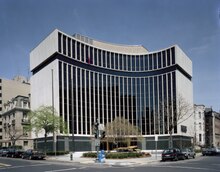User:JPRiley/Mills
| This is not a Wikipedia article: It is an individual user's work-in-progress page, and may be incomplete and/or unreliable. For guidance on developing this draft, see Wikipedia:So you made a userspace draft. Find sources: Google (books · news · scholar · free images · WP refs) · FENS · JSTOR · TWL |
Alan B. Mills | |
|---|---|
| Born | June 5, 1887 |
| Died | November 30, 1963 (aged 76) |
| Nationality | American |
| Occupation | Architect |
| Practice | Pennington, Lewis & Mills; Alan B. Mills; Mills & Petticord; Mills, Petticord & Mills |



Alan B. Mills (1887-1963) was an American architect in practice in New York City and Washington, D.C. from 1916 until his death in 1963. He was the founder of a successful regional architectural firm, Mills, Petticord & Mills, which outlived him and was acquired by Hellmuth, Obata & Kassabaum in 1975.
Life and career
[edit]Alan Balch Mills was born June 5, 1887 in Philadelphia. He was educated at the William Penn Charter School and at the University of Pennsylvania, graduating with a degree in engineering in 1909. He then worked for architects Mills & Greenleaf, Duhring, Okie & Ziegler, Kenneth MacKenzie Murchison and William Lawrence Bottomley before opening his own New York City office in 1916. In 1919 he joined the George A. Fuller Company as an assistant construction manager, where he remained until he was appointed State Architect of New Jersey in 1921. In 1926 he became architect for the J. C. Penney Foundation, for which he was responsible for the development of Penney Farms in Florida. After a year he returned to New York City where he became an associate of Louis E. Jallade, and in 1930 he joined the firm of Pennington & Lewis as a partner. Works by Pennington, Lewis & Mills include 90 Church Street (1935), designed in association with Cross & Cross for the Office of the Supervising Architect. In 1934 Mills left to join the Office, where he worked as executive assistant to Supervising Architect Louis A. Simon until 1937 and as a consulting architect until 1938. In the latter role he was responsible for the Canal Street post office (1937) in New York City.[1]
In 1938 he entered private practice in Washington, D.C. and developed a general practice. During World War II he designed Fairlington (1945) in Virginia in association with Kenneth Franzheim. In 1946 he formed a partnership with architect George W. Petticord Jr. in the expanded firm of Mills & Petticord. This was shortly thereafter expanded to include Mills' son, engineer Alan B. Mills Jr. The firm became Mills, Petticord & Mills in 1951.[2] This firm was responsible for major additions to the National Museum of Natural History and were associate architects for the National Museum of American History (1964). Mills died in 1963 but his partners and their associates, architect Loren C. Sage and engineer Hugh C. Clagett, continued the firm. In 1972 it was renamed the Mills & Petticord Partnership and in 1975 was acquired by Hellmuth, Obata & Kassabaum of St. Louis. The Mills name was retired shortly thereafter.[3]
Personal life
[edit]Mills was married to Mary Handlan and they had three children: Alan B. Mills Jr., Eleanor (Mills) Petticord, who married his business partner, and Julia (Mills) Jacobsen. During the part of his career spent in New York City the family lived in Florham Park, New Jersey, where Mills served three terms as mayor.
References
[edit]- ^ https://aiahistoricaldirectory.atlassian.net/wiki/spaces/AHDAA/pages/35729853/ahd1030681
- ^ https://www.google.com/books/edition/Amendments_to_Communications_Act_of_1934/yiZJAQAAIAAJ?hl=en&gbpv=0
- ^ Walter McQuade, Architecture in the Real World: The Work of HOK (New York: Harry N. Abrams, 1984): 36.

